Our stay at the Shepherds Arms Hotel in Ennerdale Bridge was delightful. A special highlight was barman Callum – he has an honours degree in English from Newcastle University and is now studying for his PhD. His program involves completing a thesis during the first part of his candidature, and then writing a novel. And his thesis topic? – ‘Miltonic Ideas of The Fall in the Romantic Period – 1790 to 1825’ …. or translated, ‘What they thought about Adam & Eve, the snake and the apple in Milton’s day!’. Our friendly Soil Scientist was enthralled and seemed to engage Callum in animated conversation about his chosen topic at every opportunity!
Drying walking gear on an extended hike like this can be a problem. Some accommodation houses have drying rooms, others have the central heating units in the rooms and still others have nothing (ie, central heating not on because it is thought to be warm enough without it (probably is, too – but doesn’t help when you are trying to dry clothes overnight)). At the Shepherds Arms, they have a drying room, but only staff are allowed access to it …. seemed like a very strange system to us – were we that untrustworthy? It meant that the washing that we had all done in a bath attached to my single room (remember, we were in plenty of mud on Dent Fell earlier in the day) came back the next morning in a complete jumble! I lost an expensive pair of hiking socks as a result of this fracas.
Once we had sorted the chaos of our laundry as best we could and collected our prepared sandwich for lunch, we were off for our 14 km hike to Black Sail YHA. Our route took us first along roads out of town, then along the banks of Ennerdale Water and finally along a local gravel road that progressively deteriorated as we approached the very isolated Black Sail YHA. Sherpa Van, our accommodation and bag transport company of choice, would not deliver our bags to Black Sail YHA because of the poor standard of this road, so we had to carry sufficient for two days of walking plus one overnight stay in our ‘day-packs’. This made them just a little heavier than on the previous two days.
So we’re off and headed towards the valley at the right of this picture.
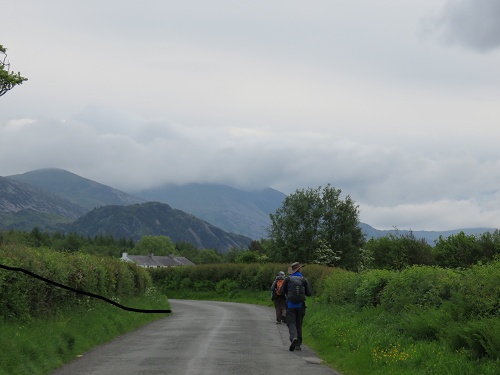 On the way out of Ennerdale Bridge, we came upon an attractive new house constructed mainly with slate.
On the way out of Ennerdale Bridge, we came upon an attractive new house constructed mainly with slate. 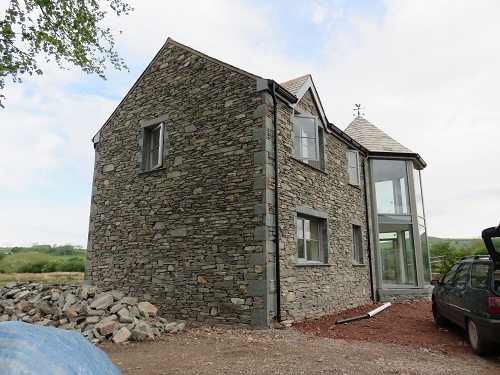 Notice the large conservatory on both levels – will be great in winter! And the detail of the construction looked quite complicated.
Notice the large conservatory on both levels – will be great in winter! And the detail of the construction looked quite complicated. 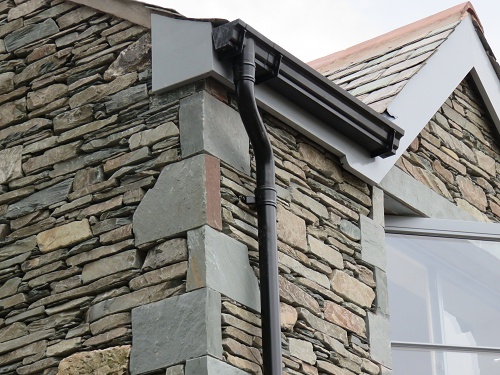 I have no idea how they build these walls, but they look impressive and I hope they last just as well as the old buildings with 40 to 50 cm thick walls!
I have no idea how they build these walls, but they look impressive and I hope they last just as well as the old buildings with 40 to 50 cm thick walls!
Pretty soon we were out of town and heading towards the local lake (and water supply) – Ennerdale Water.
It appears that the level of the lake has only been raised a little to make it into a reliable water supply for local towns. Apparently this ‘lake’ supplies water to around 60,000 households. 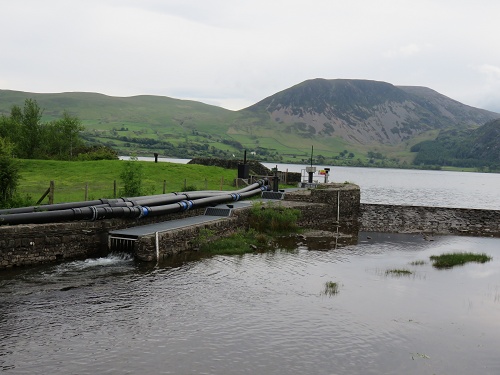
The walk along the banks of the lake was a highlight of the day, starting with a very well-made walking track.
And the sheep grazing lands on the opposite bank were a delight with their dry stone walls. 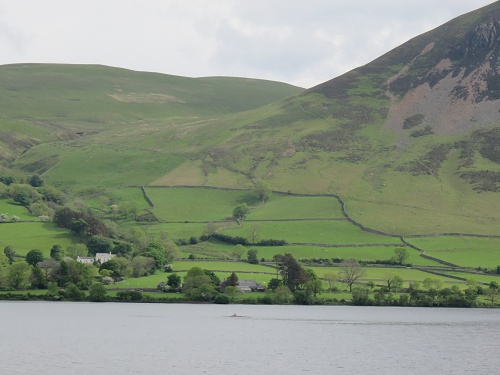 Pretty soon we came to a feature named (for no known reason) ‘Robin Hoods Chair’. ‘You mean we have to go up there?’ – Tricia seems to be saying!
Pretty soon we came to a feature named (for no known reason) ‘Robin Hoods Chair’. ‘You mean we have to go up there?’ – Tricia seems to be saying! 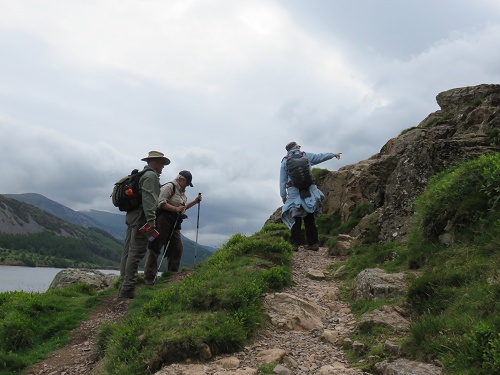 Seems like the answer is – ‘Yes!’.
Seems like the answer is – ‘Yes!’.
For about half a day, we walked with a chap called Richard who was doing the C2C solo. So he was up for a chat on any topic that anyone wanted to raise – and a thoroughly pleasant fellow he was too. He was on a much more punishing schedule than us, covering about twice the distance we did that day. Here he is, heading up towards Robin Hoods Chair. 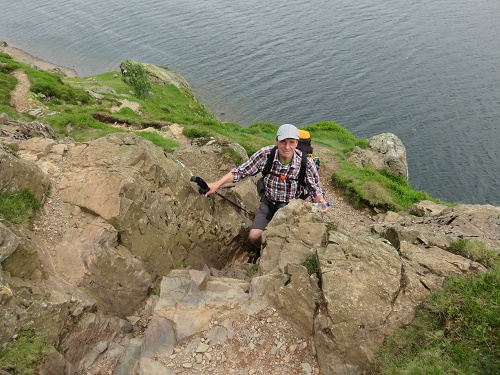
After this steep and rocky diversion from the water’s edge, the path started to become a little rougher – a foretaste of things to come as we continued our journey into the heart of the Lake District.
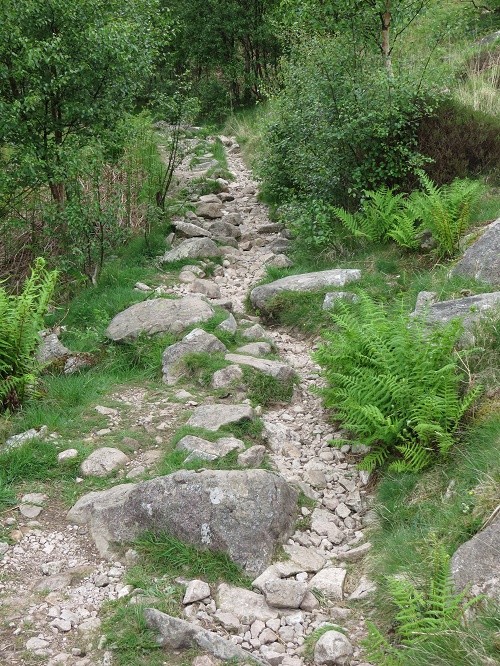
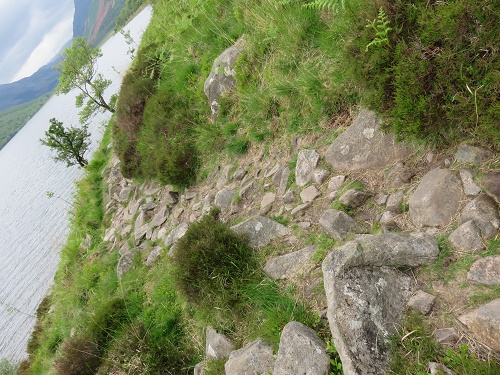 But the scenery was no less spectacular! In the middle of the picture below you can see the valley that we were headed for. At the start of the day, some of us had been keen to take the alternative high route, via the ridge and peaks on the upper left of this photo, particularly over Red Pike, High Stile, High Crag and Hay Stacks as you move along the ridge. As you can see, the clouds were getting low and in fact the rain started shortly before we reached the turn-off to Red Pike. So we decided against the high route. But Laurie was still keen, so later he took a solo side trip up to near Hay Stacks. When he arrived later at Black Sail, he reported that there were lots of people up on the high path – seems like these Lakeland folk don’t let a little cloud and rain put them off!
But the scenery was no less spectacular! In the middle of the picture below you can see the valley that we were headed for. At the start of the day, some of us had been keen to take the alternative high route, via the ridge and peaks on the upper left of this photo, particularly over Red Pike, High Stile, High Crag and Hay Stacks as you move along the ridge. As you can see, the clouds were getting low and in fact the rain started shortly before we reached the turn-off to Red Pike. So we decided against the high route. But Laurie was still keen, so later he took a solo side trip up to near Hay Stacks. When he arrived later at Black Sail, he reported that there were lots of people up on the high path – seems like these Lakeland folk don’t let a little cloud and rain put them off! 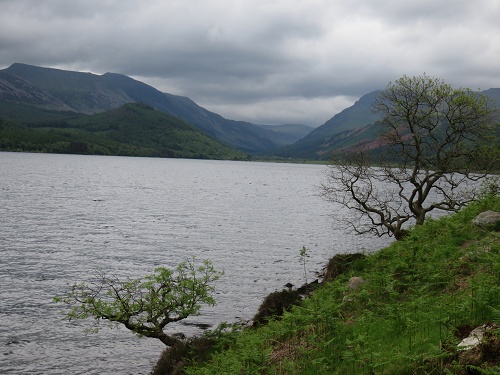 As well, we were starting to see more large scree slopes, typical of true Lakeland landscapes.
As well, we were starting to see more large scree slopes, typical of true Lakeland landscapes. 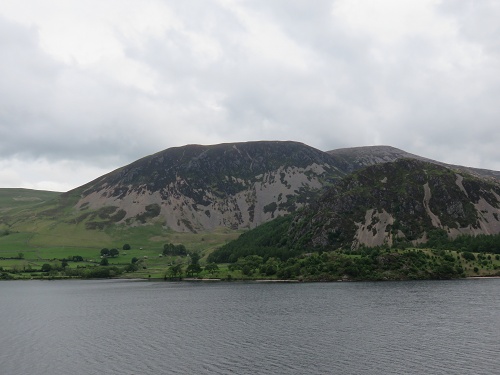
As we walked, we noticed dead patches in areas of sown forest. From a distance, these appeared to be the result of fire damage. 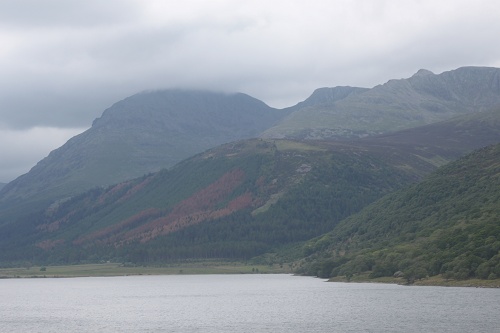 But not so. Further along the path, we came across a couple of explanatory boards.
But not so. Further along the path, we came across a couple of explanatory boards. 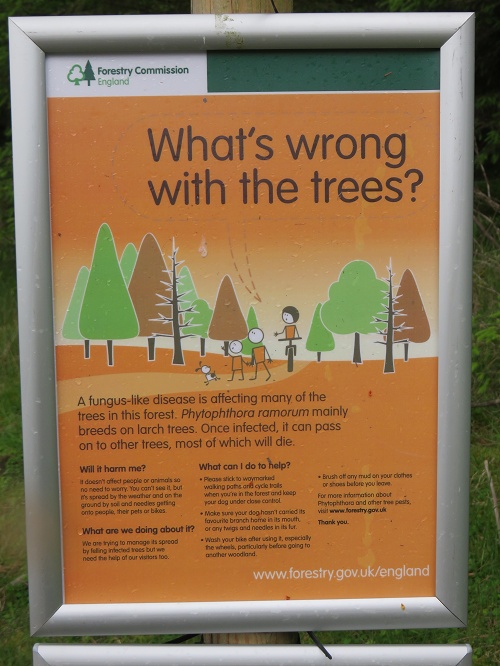
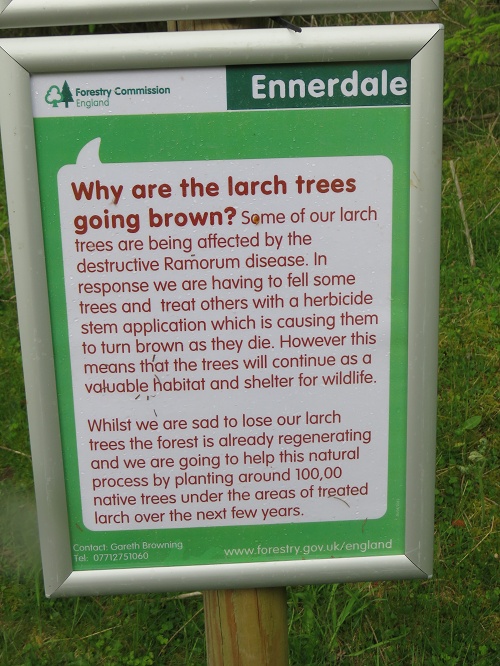
In summary, any trees affected by the soil bourne Phytophthora fungus will die, probably assisted by human-applied herbicide to help limit spread of the disease. And the areas of forest lost to the disease will be re-planted in time with native species, presumably ones that are not susceptible to the fungus.
A related fungus is a significant problem in native forests in Australia. I recall washing our boots in anti-fungal agents at the entrance to several National Parks in South-East Queensland during our training walks.
Eventually, we arrived at the top of Ennerdale Water and came across the fast-flowing River Liza.
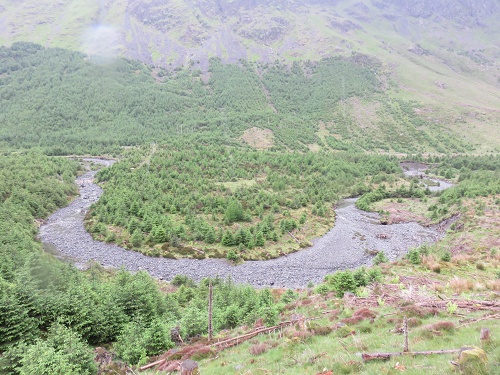
It was interesting (and surprising to me) to see that the geological profile of the stones in the Liza was similar to that seen back on the beach at St Bees.
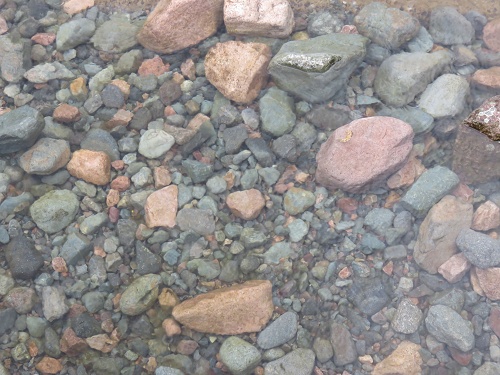 By now it was raining and we each had our particular array of gear to attempt to keep dry. In my case it included a Gore-Tex and a poncho (no water-proof trousers at this stage). This had the advantage of keeping both my pack (back) and SLR camera bag (front) safe from the weather. Everyone else I saw on the walk preferred to use a rain-proof jacket and a pack-cover. In fact, pack covers are not very effective if the weather turns really nasty. And rain jackets can be far from water-proof as well. On the other hand, I was very confident that no water was going to penetrate my plastic poncho! So even though I looked a sight, I was very happy with my choice of gear!
By now it was raining and we each had our particular array of gear to attempt to keep dry. In my case it included a Gore-Tex and a poncho (no water-proof trousers at this stage). This had the advantage of keeping both my pack (back) and SLR camera bag (front) safe from the weather. Everyone else I saw on the walk preferred to use a rain-proof jacket and a pack-cover. In fact, pack covers are not very effective if the weather turns really nasty. And rain jackets can be far from water-proof as well. On the other hand, I was very confident that no water was going to penetrate my plastic poncho! So even though I looked a sight, I was very happy with my choice of gear! 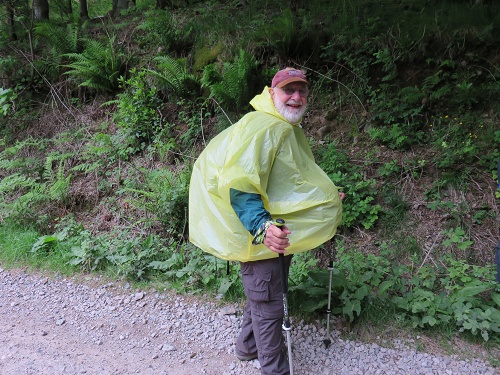 By now, the valley was starting to close in and the fells above were spectacular
By now, the valley was starting to close in and the fells above were spectacular 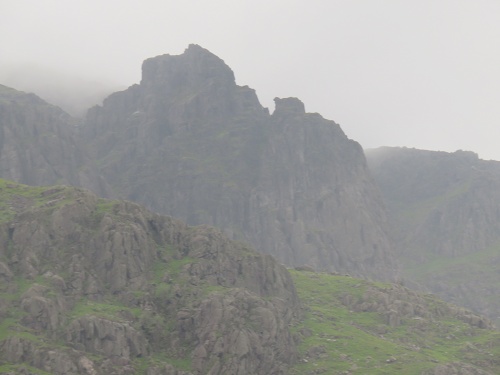 Even the rain and mist added an extra mystique to the landscape.
Even the rain and mist added an extra mystique to the landscape. 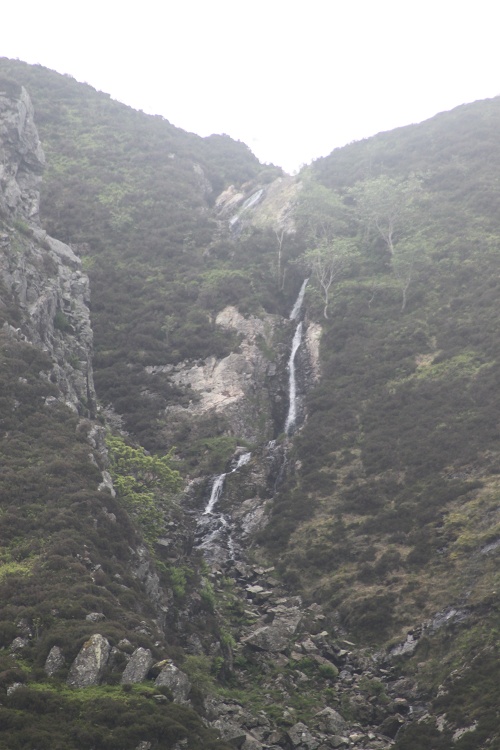 The gills were swollen and the green valley-sides appeared verdant.
The gills were swollen and the green valley-sides appeared verdant.
Eventually, we came upon the delightful Black Sail YHA just in time for a late lunch – that’s it in the distance. It was originally a shepherd’s bothy.
We enjoyed a lazy afternoon, a delightful home-cooked meal in the evening (included rhubarb pie for desert – one of my favourites!) and a surprisingly restful night in bunk beds (four to a room, men and women segregated). But we had been warned that, while there were power points in the rooms, they conveyed no power. Unfortunately, this advance information proved to be 100% accurate! But this slight inconvenience was more than compensated by the charms of the delightful young Scottish lass (Alison) who was the host (and chef) at the YHA. 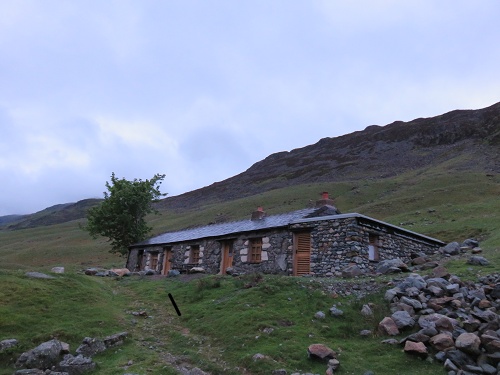 Vital stats for this stage
Vital stats for this stage
Distance for this stage: 14 km
Total distance covered: 41 km
Ascent: 100 m
Total ascent: 805 m
Level of difficulty: Easy
Highlight: The delightful walk along the southern shore of Ennerdale Water

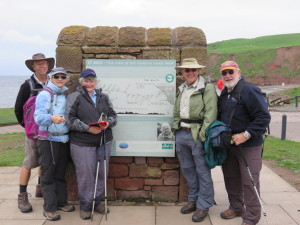
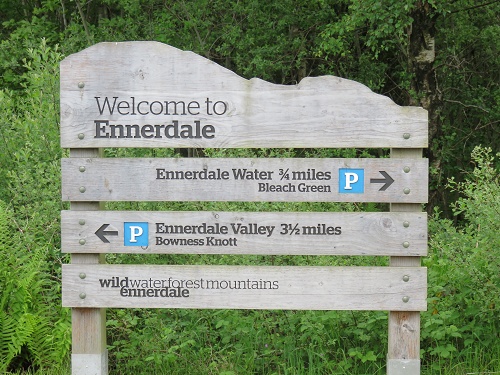
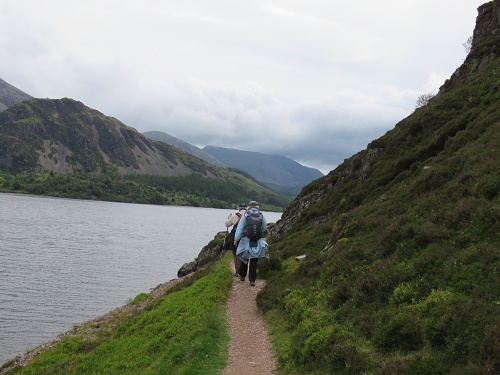
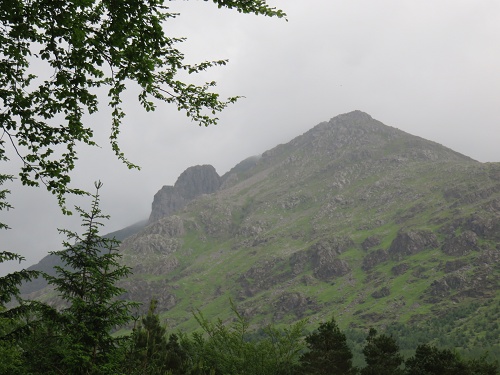
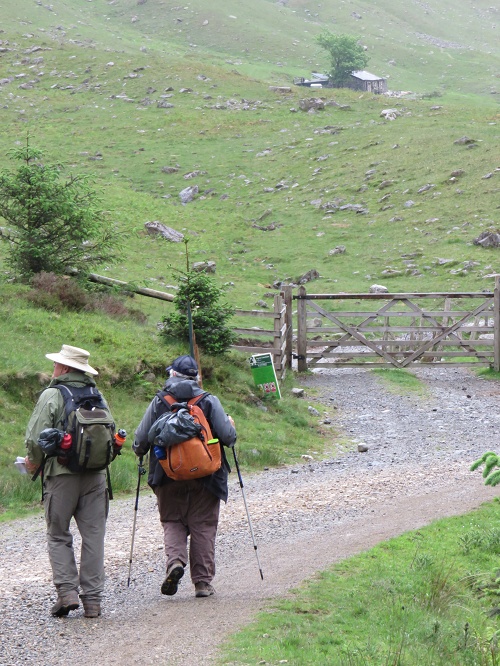
Len, that track on Robin Hood’s Chair looks as bad underfoot as the middle part of the Milford Track!
Cheers!
Some dramatic landscape there – I’m enjoying seeing these posts pop up in my email alerts. Brings back memories of some long walks in Wales many years ago.
Hi Len,
I note that some of your party were using walking poles. I’m planning to do some hiking in Iceland in August; in the past I haven’t bothered with them but would be interested to hear your opinion on whether they are worthwhile.
Robert, Len will no doubt have an opinion. My wife and I both used them on the Milford track. We found them helpful going uphill, downhill and on the flat. Wouldn’t attempt a decent walk without them.
On our walk they were available for hire, so we didn’t have to take them on the plane.
Some people use only one, but we both preferred two.
Thanks Len for a great summary of that leg of our journey, it brought it all back to life for me, it is amazing how one day melded into another on the walk.
Thanks Tricia. It’s all becoming a large and intermingled dream now for all of us, I think. So I’m determined to press on as time permits – most will have to be done after I get home. I have the photos and many pages of notes -and interesting stories to tell. Who could forget our beloved ‘Dutch lady with wooden walking staff’ who kept popping into our lives, sometimes in the most unexpected places, or the ‘Ladies of the Lake’ as well as many others! And the driving rain, mist and gloom of Kidsty Pike, then the bright sunshine! Memories!
Brian @ 1 – it got worse as we walked through the Lake District!
tigtog @ 2 – pleased that you are enjoying our adventure – thanks for the feed-back.
Robert @ 3 – I would use walking poles if I did this or a similar walk again. Three out of the five of us in our group started with poles and two of us used them all of the way. The third stopped because of a shoulder problem. I found them helpful in three ways:
1. Going up steep hills – they transfer some of the work to your upper body, so for me, tackling the hills was much more pleasant using poles;
2. Going downhill, or down steps – using poles helps to reduce jarring on the lower body, especially knees; and
3. On the flat – useful to reduce stress on lower body, especially if something (eg a knee) is a bit sore.
If you do buy a pair, I would look out for the following features:
1. Slight spring shock absorbing system – helps to reduce the harshness of the initial strike on hard surfaces such as stone or bitumen;
2. Soft touch ergonomic handles – much more pleasant to use over long distances than the cheaper ones;
3. Easy and secure length adjustment, preferably with height markings so that you can easily adjust them back to your preferred lengths for uphill and downhill; and
4. A small flange about 5 cm from the trike-point – this is very useful if you need to tackle mud or peat bogs – plenty of these on the C2C walk!
Finally, do plenty of walking with them before using them on tricky terraine. Need to get used to using them without having to think too much about where you’re putting them. As well, you need to develop upper body fitness in the muscles involved through shorter walks before tackling a long day of walking.
Hope that helps!
Hi Len
I liked reading stage 3 of Your trip. Nice pictures.
I also took the South side of Ennerdale water. I had a big struggle with Robin Hoods chair.
My wooden stick is at least 10 cm shorter after the c2c.
I look foreward to the next day.
groetjes Ilonka
Hi Ilonka, Pleased you enjoyed the post of our Stage 3.
Folks, we haven’t yet met Ilonka on our C2C journey. But she will appear after a couple more stages as ‘The Dutch Lady with the Wooden Staff’! After we first met each other in a ‘pea-souper’ on the way up to Kidsty Pike, our paths crossed many times as our adventure continued, right across to Robin Hoods Bay.
All I’ll say right now is that Ilonka is one courageous lady!